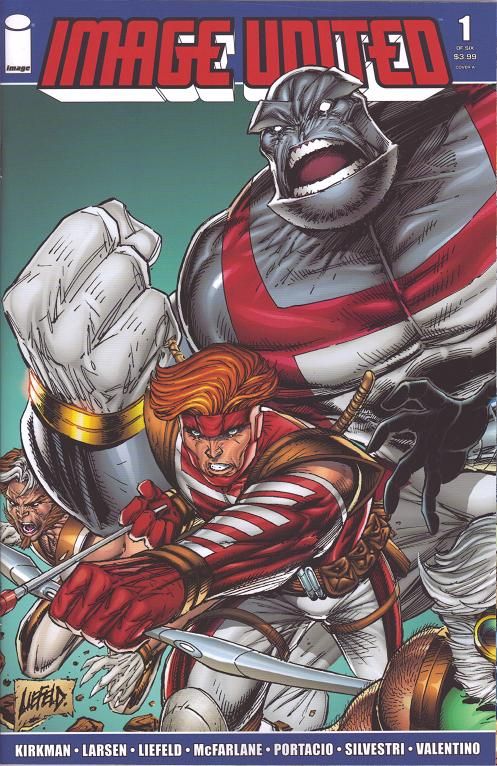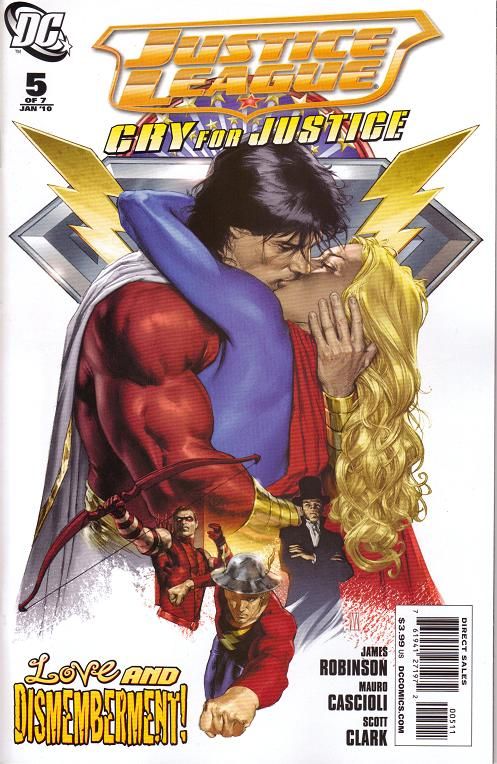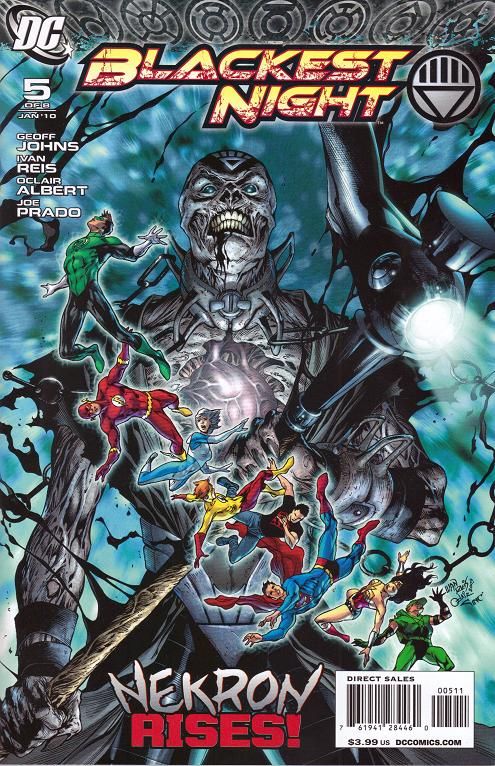Or; Why many, many superhero comics these days make me blue. (SPOILERS ahoy, by the way.)
Every once in a while I have to defend myself against the people who say I hate superheroes. (Occasionally I have to defend myself against the people who say I love superheroes too much, but that's a whole different post.) Let me make this clear: I LOVE superheroes. Really. I would love to read more superhero comics. I used to read more superhero comics, but somewhere along the way, I started buying fewer and fewer. I know I changed as I got older, but so, I would argue, did superhero comics. That's just the way it is.
This week, however, was a bit of an interesting week in the realm of superhero comics. No huge series ended, but a series began that probably counts as a big event, and two other big series had middle-of-the-run issues come out. I thought I'd give them all a try to see if they could lure me back into the convoluted world of superherodom. Unfortunately, they couldn't. But I'd like to consider why they didn't.
The three comics were: Image United #1, Justice League: Cry for Justice #5, and Blackest Night #5. I completely understand that these issues are parts of a whole, and even Image United shouldn't be considered any kind of complete story, but I don't care too much about that. I'm not concerned about what's going on in these issues, just puzzle out why they don't excite me at all. I understand why many, many people like these books, but I'd like to look at why I don't.
Several factors go into these superhero books. An obvious one, of course, is the characters and their brightly-colored costumes, often clashing with the "maturity" of the themes involved. Each of these comics boils down to a villain or villains fighting heroes, and they're about as simplistic as that. There's nothing wrong with that, I should point out. But I'll get back to the mature content of these books. Beside the heroes-vs.-villains theme, however, a few factors stand out:
1. Nostalgia. Nostalgia has, for many years, been a huge part of superhero comics. This is, in fact, one of the reasons why I think I've drifted away from them. I've spoken for some time how I have what our own MarkAndrew calls "reverse nostalgia," meaning I care not for Golden Age and Silver Age heroes. Part of this stems from the fact that I didn't read comics when I was a kid and by the time I came to comics, I hadn't formed those bonds to certain characters that meant I would follow them everywhere no matter what.
I love certain characters, but I don't follow them slavishly. I feel nostalgia for certain things (the self-titled Genesis album from 1983, Manimal, Roger Zelazny's Unicorn Variations), but not comics.
These three issues, however, wallow in nostalgia. Blackest Night is based on the idea of bringing corpses back from the dead, which we can read as a metaphor for nostalgia, if we so choose. Image United is based around the idea of the original Image creators drawing a comic, just like in the olden days. In the text piece at the end of Cry for Justice, James Robinson writes a virtual paean to the Golden Age comics, even if the issue itself is less nostalgic than the other two. I have no idea how old Robert Kirkman is, but Image United feels like something a young adolescent would have written back in 1992 if he had the chance to work with Erik Larsen, Rob Liefeld, Todd McFarlane, Whilce Portacio, Marc Silvestri, and Jim Valentino. Perhaps Kirkman is older than that, but I can't imagine he didn't read Image books when they first came out and thought they were pretty awesome. Now he's getting the chance to write his own story and work with these artists. Geoff Johns was born in 1973 (according to Wikipedia), so he was 12 when Crisis on Infinite Earths came out. If he was reading comics back then (I have no idea if he was or not), would he have felt ripped off that Barry Allen died? Is Barry's resurrection a consequence of this adolescent anger? Does Johns's love for Hal Jordan stem from years of reading Green Lantern so many times until the pages fell apart?
(This is all a moot point if the return of Hal Jordan and Barry Allen is editorially mandated, of course.) One reason why I'm not the biggest fan of Geoff Johns is not because I think he's a terrible writer, but because I don't share his adoration of the same characters. He can't make me feel the love that a pre-teen boy feels for characters that are his childhood heroes. As nostalgia is a big part of these issues and superhero comics in general, I find myself less interested in them. That's just me.
Another theme is:
2. A reliance on continuity. This ties back into nostalgia, to a certain degree. If I have no obsessive love for a certain character, I'm not going to follow them around and know what's going on with them in current continuity. I love Rogue, Psylocke, and Dazzler, but I have no idea what's going on with them currently, because I haven't been interested enough in the X-books to find out. If I don't know what's going on with characters I really love, I'm not going to be up to speed with characters I don't care about. These comics don't do a good job getting us up to speed, which is not a complaint, just a fact. If you've been reading superheroes a lot for years, you can probably keep up, but it's difficult to dip into hard core superhero books these days as a casual reader. Kirkman introduces the characters in Image United, but then he goes back in time and shows us a bunch of characters we're supposed to know, I guess, but I don't. The appearance of Al Simmons is supposed to be very dramatic, but it's only dramatic if you know and have some kind of emotional connection to Spawn. Of course, the people who buy these comics are probably going to have that connection, but not necessarily. In both the DC books, there are several characters - e. g. Hawkman, Firestorm - who I thought were dead. Yet there they are, big as life. I'm sure it's been explained why they're not dead, but I don't know what it is. Buddy Baker mentions the Forgotten Heroes (I never knew about them, so didn't even forget them!), several people show up in Blackest Night and Cry for Justice who are identified only by first name, and we get no indication what's going on with Shadowhawk in Image United. None of these are deal-breakers when you're reading the book, of course, but it means that it's very helpful to have read a bunch of earlier comics to get the full effect of what's going on.
A third theme of these comics is:
3. The "illusion of change." A few years ago, Dave Fiore coined a marvelous term, "dynamic stasis," to explain the illusion of change in superhero comics. I don't need to get into the reasons why superhero writers and the Big Two feel the need to pretend that things change in their comics without actually changing anything, but it's certainly in full effect here. It's not as obvious in Image United, as it's the first issue and is mostly set-up, plus the heroes are fully owned by the artists, so if they want to change them, they can (they probably won't, though). Lots of things happen in the DC books, however, but as a jaded comic book reader, I don't buy any of them. As I wrote, several characters who have been dead in the past are alive and well in Cry for Justice and Blackest Night. It's somewhat of an in-joke of Blackest Night that so many characters were once dead, which in such a deadly serious book, clashes severely with the tone. But Robinson and Johns put their characters through the wringer to give us the illusion of change, even though anyone who's ever read a comic book knows things will reset soon enough. The big event in Cry for Justice is Roy Harper losing his arm (well, and the revelation of the bad guy, I guess). To me, at least, this scene has no impact, because it doesn't matter. I don't think Roy will get his arm back, but in a DCU where Cyborg exists, he'll have a prosthetic arm in no time. Some writers may show Roy agonizing over his lack for a panel or two, but I very much doubt it will keep him from kicking ass. I have no idea who's going to "die" in Blackest Night or Cry for Justice, but does anyone really believe anything will happen to any major characters, and if so, that it will last?
Now, again, there's nothing wrong with never changing your characters. DC and Marvel are corporations, and their characters often stay the same because of movie tie-ins and whatnot (let's call this the "When is Bruce Wayne coming back because there's no way another movie is coming out without Bruce as Batman" clause). But for writers to write something that they know won't stick is a bit dishonest, and I'm certainly not excusing writers I like from this (Morrison "killing" Batman, for instance, which was apparently somewhat editorially mandated). But the Big Two want it both ways, and that's annoying. The two DC comics want to present these stories as "changing everything," but they really change nothing. We all know it going in, so if you accept that, that's fine, but I don't accept it. Many of the superhero comics I do read feature characters who can change and often do. No DC or Marvel book is going to perfect in that regard, but when you use such icons of the corporations, it's even more obvious.
Tying into this, a fourth theme:
4. The "illusion of maturity." I have railed against this in superhero comics for years now, and these issues have it in spades. Image United is a much more straight superhero comic than the other two, and Kirkman is interested (in this issue at least) in simply showing the heroes beating on bad guys, which they do with gusto. One bad guy gets decapitated, but he's kind of a cyborg and it's more goofy than disturbing.
It's basically hot chicks and chiseled dudes beating on malformed evil dudes. It's mildly offensive to good taste, but nothing more or less than any normal superhero book. The two DC books, however, aspire to more. They're "mature" in the worst possible way, meaning the writers are given free rein with regard to violence but can't (or simply don't) do anything else. Consider: In the first panel of Cry for Justice, Cliff Baker asks his mother why he can't play in the pool, to which Ellen answers, "Because Kory and her friend are out there, and it's always a gamble if Kory will have her clothes on." Now, as she's a DC character, no reader has ever seen Kory naked in a DC-licensed comic, but the big joke in the DCU is that Kory doesn't mind getting naked. Simple nudity of an alien from an alien culture is played for laughs and will never happen, but we can get a beautifully drawn full-page shot of Roy Harper with no arm. For those of you who believe that I want all my DC and Marvel superheroes naked all the time and engaging in rough sex with each other, I will say once again: I have no interest in that, but I find the skeevy attitude toward nudity in mainstream superhero comics weird when you compare it to the gleeful attitude toward gruesome violence. You may argue with that take on the violence, but then we have the icky scene in Justice League of America #39, where the villain (Black Lantern Dr. Light) licks the head of a dead woman and says it tastes salty, or Black Hand's sort-of intimations at necrophilia in Blackest Night #5 (I don't think his crack about Barry Allen not being his type is definitely a joke about necrophilia, but based on his other comments, I wouldn't rule it out). There's not a tremendous amount of gore in these two issues (yes, Roy's missing an arm, but that's about it), but these issues are somewhat symptomatic of the way superhero comics go these days.
We get horrible violence with very few consequences, a puritanical attitude toward nudity (again, not sex) and a reluctance to be really "mature" because corporate superheroes are basically meant for kids. I want to reiterate - there's nothing wrong with that. I accept that. I love superhero books that revel in that spirit, even if they're a bit more "mature" (I'm thinking of Jay Faerber's superhero books for Image, Noble Causes and Dynamo 5, which don't indulge in horrible violence - although they are violent - and which address some more "mature" themes but are also books that are in the spirit of "fun" superhero books). What many Big Two books indulge in is, again, this puerile attitude toward their superheroes - we can make jokes about sex and nudity but never show it, we can have horrific violence because it's kewl and we never have to show the consequences of it. I've said it before, DC and Marvel, and I'll say it again: Shit or get off the pot. This half-assed attitude toward "mature" superheroes is idiotic. But that's just me.
I can certainly see the appeal of these comics, don't get me wrong. I, personally, don't think they're good, but I can see why people do like them. Image United features several artists who still have legions of fans, and Kirkman is a fairly decent writer who might be able to make what seems a bit of a mess right now into something good. Lots and lots of fans enjoy what Johns is doing and love the idea of "DC Zombies." I have no idea how Cry for Justice is selling, but I wouldn't be surprised if it's doing well. The art from Ivan Reis (on Blackest Night) and Mauro Cascioli (on Cry for Justice) is quite good. And they star popular characters. What's not to love?
Well, for me at least, plenty. These kinds of books just don't do anything for me. As you can see, I don't even think they're laugh-out-loud horrible. They're just mediocre, and that's too bad, as the creators certainly have talent. I know nobody cares about why I don't read a ton of mainstream superhero books, but I'd thought I'd point out some of my reasons and how these three books embody what I don't like about superhero comics. It's too bad. I would love to buy more superhero comics, because they're awfully keen. But I can deal with reading the many other genres that have become more prevalent in comics over the past decade. I get a lot more pleasure out of those anyway.
Sorry, this wasn't much of a rant. I just can't get too angry about these comics. I'll make a better effort next time!




